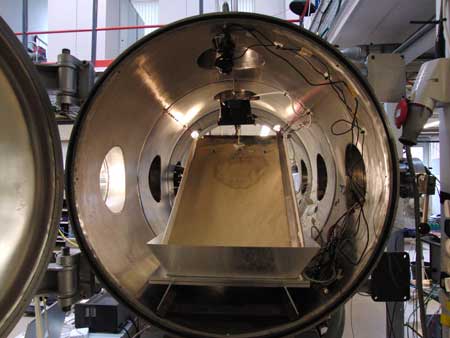| May 03, 2016 |
Mars: Boiling water could be carving slopes into the planet's surface
|
|
(Nanowerk News) Active features observed on the surface of Mars could be the result of liquid water boiling whilst flowing under the low pressure of a thin atmosphere, according to an Open University study published online this week in Nature Geoscience ("Transport processes induced by metastable boiling water under Martian surface conditions").
|
 |
| Mars simulation chamber.
|
|
The low pressure on the surface of Mars means that water is not stable for long and will either quickly freeze or boil; liquid water therefore exists only very temporarily. The streaks and slopes that have been observed and seen to lengthen on Mars during its summer had previously been attributed to flowing salty water. However, new research indicates the reason for this could be altogether more explosive, as sand particles on the planet’s surface are ejected by the rapidly boiling liquid.
|
|
Scientists at The Open University used their unique Mars simulation chamber to conduct experiments of water flowing down a slope of martian surface material, under martian atmospheric temperatures and pressures. A block of ice was placed on top of a sandy slope and under Earth-like conditions, little change was observed to the slope as the ice melted and trickled downwards.
|
|
Using The Open University’s unique Mars simulation chamber, the experiment was repeated but under simulated Mars conditions. With the lower air pressure, the melting water rapidly boiled as it flowed and disrupted the sand by explosively ejecting the surface material, with grains piling up and forming small channels which resembled those observed on the surface of Mars.
|
|
Dr Manish Patel, who was part of the research team and responsible for the Mars simulation chamber says: “Water on Mars is generally unstable and it’s this sudden boiling during the flow of the water which is the key process that could be causing these small channels on the surface. This discovery has the potential to change how we interpret these kinds of geomorphological flow features on surface of Mars, and clearly shows us that there are important differences in how water-related debris flows occur on Earth and Mars.”
|

